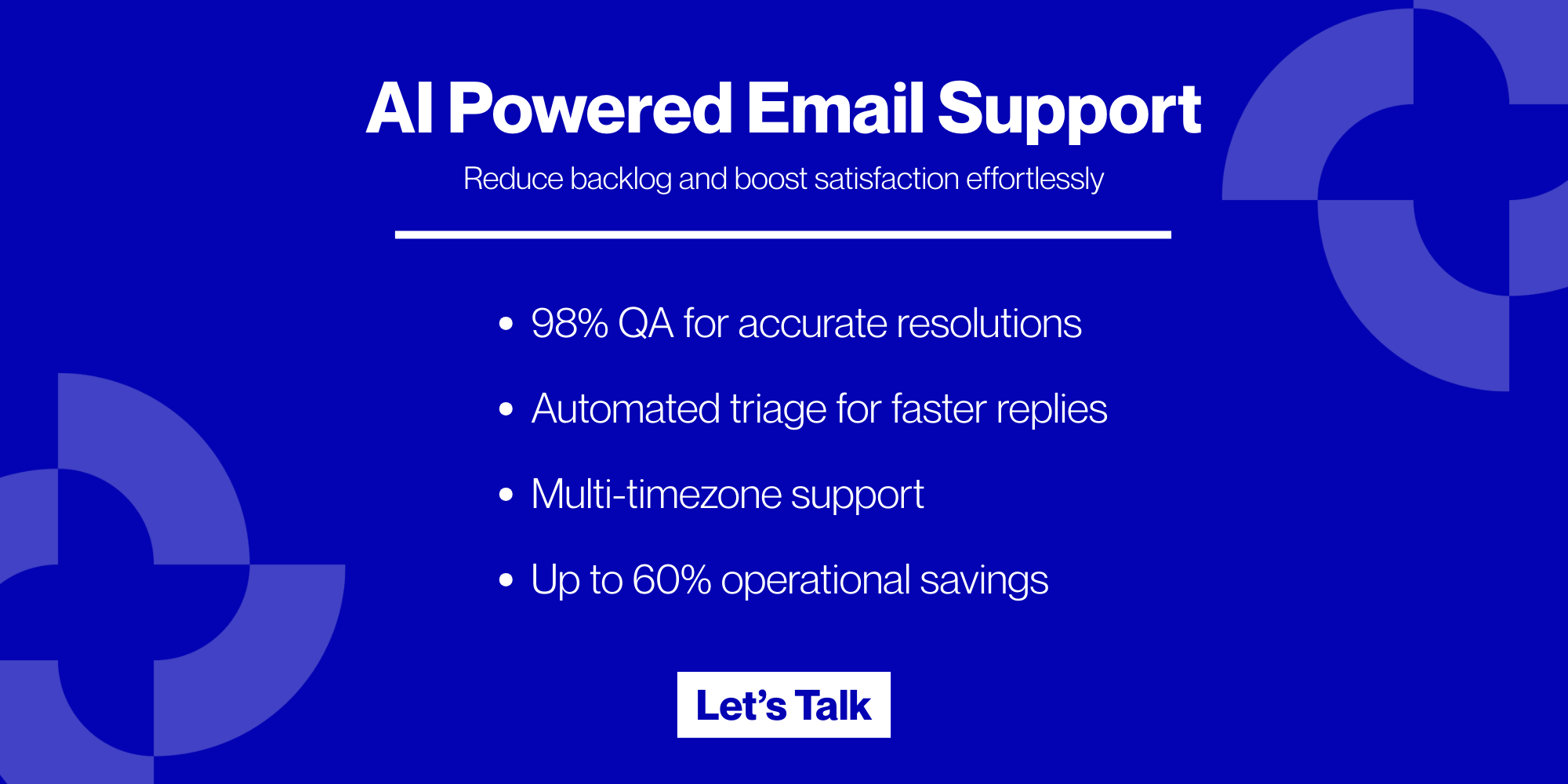Table of contents
- Introduction
- What are the hidden costs of effective email handling for customer support?
- The time and productivity of the employee
- Professional development training
- Technology Advancement investments
- Increased Stress and Decreased Employee Well-Being
- Missed Opportunities and Decreased Collaboration
- Flexibility challenges
- Delay in Response Time
- What is the customer service cost per email ?
- Final thoughts
- Frequently Asked Questions.
Introduction
When it comes to business, it is very important to have a healthy relationship with customers. Even in this modern business world, Email is considered to be one of the major communication media. The email is quick, user-friendly, and dependable. But do you know that even a simple “Thank you” message has a lot of internal processes, human effort, and tools? Yes, email might seem simple. But for effective email handling for customer support, the business has to undergo a lot of teamwork.
From software and training to compliance and staff well-being, companies commonly underestimate the unseen expenses that create “effective” email management a reality. What may seem like a simple support channel can actually be a silent drain on the company’s resources if not managed. Identifying these unseen internal costs is the first step in developing a support system that is equal to quality, pace, and sustainability.
This blog will walk you through the hidden costs of effective email handling for customer support and the parameters behind the customer service cost per email.
What are the hidden costs of effective email handling for customer support?

Email is widely used by all businesses and brands. But do you know what is the unnoticed part? It is the hidden costs that lie behind email marketing. Take a look at the hidden costs of effective email handling for customer support.
1. The time and productivity of the employee
The researchers have shown that an average employee spends around 28% of their time managing emails. Emails need to be read, understood, and a personalized reply. Over one day of the workweek is dedicated solely to reading and responding to emails. While email serves as an essential communication tool, it is impractical for any single task to consume this much time.
In certain organizations, there is an expectation for employees to reply to emails without delay. This expectation is unrealistic, especially when an individual is faced with a flood of emails. The incessant influx of emails can disrupt a worker’s concentration, divert their attention from important tasks, lead to forgetfulness regarding their current work, or result in errors. When there are tons of emails and you are taking a lot of time to respond to each email, there is a higher chance that productivity is affected.
2. Professional development training
When there is a team for handling customer emails, they need to be provided with the proper training. They should be mindful about the tone they use, showcasing empathy towards the customer, and a proper knowledge about the brand or business they are working with, and above all, a keenness to resolve the technical troubleshooting. For a brand to stand out in this competitive world, it should have a trustworthy customer support team. They should be reliable to meet the customer expectations. The organizations need to give proper training and skill development programs. Investing in training and ensuring consistency can improve the overall performance, but can add to internal costs.
3. Technology Advancement investments
Do you ever feel that email handling for customer support is inexpensive? At first glance, email is all about handling the inboxes and a stable internet connection. But when customer support grows, companies have to depend on scalable email management software such as Zendesk, Freshdesk, or Salesforce Service Cloud. These tools simplify ticketing, automate processes, and consolidate communication, but carry hefty licensing charges that rise as the team expands.
Aside from licensing, integration expenses come quickly. In order to run smoothly, these platforms need to be linked with CRM systems, ticketing solutions, and in-house knowledge bases. Each integration requires setup, customization, and regular maintenance, usually involving specialized IT skills. The unnoticed costs behind the effective email handling for customer support often involve software updates, IT support, and troubleshooting.
4. Increased Stress and Decreased employee well being
Dealing with never-ending emails and deadlines can cause stress and affect the overall well-being of your employee. Sometimes they even miss out some critical messages to respond to within the stipulated time. Have you come across the term worker burnout? Researchers have shown that around 43% of employees are facing worker burnout. It can affect productivity, which can lead to employee churn.
5. Missed Opportunities and Decreased Collaboration
As the volume of incoming emails increases, previously important messages that remain unaddressed sink further into the inbox, becoming increasingly difficult to locate. At this point, they become nearly undetectable. Employees burdened with overflowing inboxes are bound to overlook these emails, or at the very least, respond to them belatedly.
In the rapidly evolving digital work environment, the inability to reply promptly or at all can adversely affect decision-making and collaboration, potentially resulting in misunderstandings and lost opportunities.
6. Flexibility challenges
When the business is growing, you may feel it is easy to handle the emails. But as the business expands, the number of emails also increases. With the growing customer base, you will need a well-trained team to handle customer inquiries. But what most companies fail to realize or notice is the customer service cost per email. To meet the customer expectations, the company needs to invest in a coordinated expansion of its technical backbone and employee base. This is really cost-efficient.
7. Delay in Response Time
Another roadblock in effective email handling is response time and SLA adherence. With volumes going up, holding back becomes unavoidable unless the team expands aggressively. Customers nowadays crave quick, personalized responses, and an inability to meet those expectations can damage brand reputation as much as excessive spending can hurt budgets.
The secret to overcoming such scalability issues is to make strategic investments in automation, AI-powered responses, self-service tools, and high-quality knowledge bases to manage repetitive questions. By delegating routine issues to technology and enabling customers with self-service, companies can be able to sustain service quality without a proportionate rise in cost.
What is the customer service cost per email?

Do you know what the customer service costs per email ? It is nothing but the average expense the business or company spends on sending mail to the customers. It is calculated to have a track on the efficiency, the cost spent on the support organizations, and more than that, to upgrade the optimal costs. You can calculate the customer service cost per email with this simple formula,
| Cost Per Email = Total Customer support costs
____________________________ Total number of Emails handled |
Take a look at the parameters affecting the customer service cost per email.
| Parameters | Significance | Effect on cost |
| Average Handling Time | Reading, comprehending, and responding to the email | The longer the AHT higher the cost |
| Complexity of Query | Basic FAQs vS. The technical queries. | Complex Queries are directly proportional to the increased cost. |
| Number of Interactions | Single-touch resolution vs. multiple back-and-forth emails | As the interactions increase, the costs multiply. |
| Agent Skill Level & Training | Specialized knowledge (IT, finance, healthcare) warrants greater investment | Trained agents increase cost per interaction |
| Email Volume | Increased volume reduces per-unit price (economies of scale), but overwhelmingly raises cost if not controlled | Low or high, depending on how efficient |
| Use of Automation/AI | Automated templates, AI responses, and routing decrease agent load | Automation decreases cost |
| Software & Tools | CRM, ticketing, and analytics software carry licensing & upkeep expenses | Adds overhead per email |
| Geography & Labor Costs | Onshore support hubs are more expensive than offshore ones | Location has a direct effect on cost |
| Quality Assurance & Monitoring | Managers checking tone, accuracy, and compliance add another layer | Increases cost |
Final Thoughts,
An effective email is crucial for maintaining an effective customer relationship. The email you send to your customers should be comprehensive, empathetic, and personalized. Email remains one of the most commonly used customer communication channels. The hidden costs always remain unnoticed. Right from training the employees to the software upgrades, everything is paid one way or the other. Sometimes this can even affect the overall productivity.
This blog has given you a proper insight into the hidden costs of effective email handling for customer support. By balancing both the hidden costs and the customer satisfaction, you can improve your business and take it to the next level.
FAQs on effective email handling for customer support
1. What are the hidden costs of effective email handling for customer support in 2025?
The hidden costs of effective email handling for customer support are software updates, training for the employee, worker burnout, compliance, and scaling.
2. How to reduce the hidden costs of effective email handling for customer support?
You can reduce the hidden costs by outsourcing the email customer support team, introducing AI, and building a strong self-service knowledge base.
3. Is email still worth investing in relative to other channels?
Yes, email is a reliable, professional, and audited support channel. However, it needs to be coupled with chat, self-service, and AI tools to ensure costs are managed while quality is maintained.

